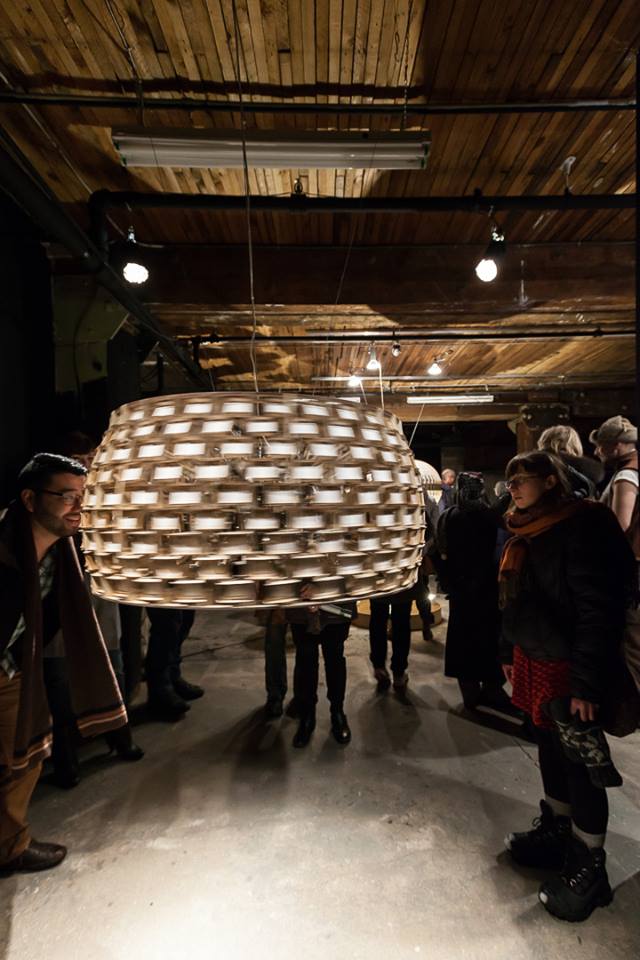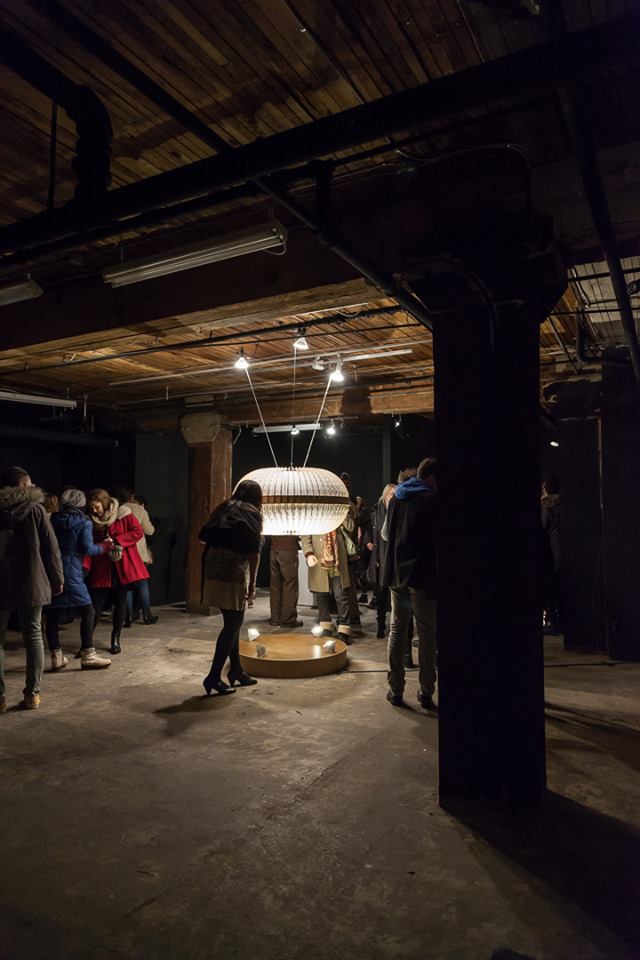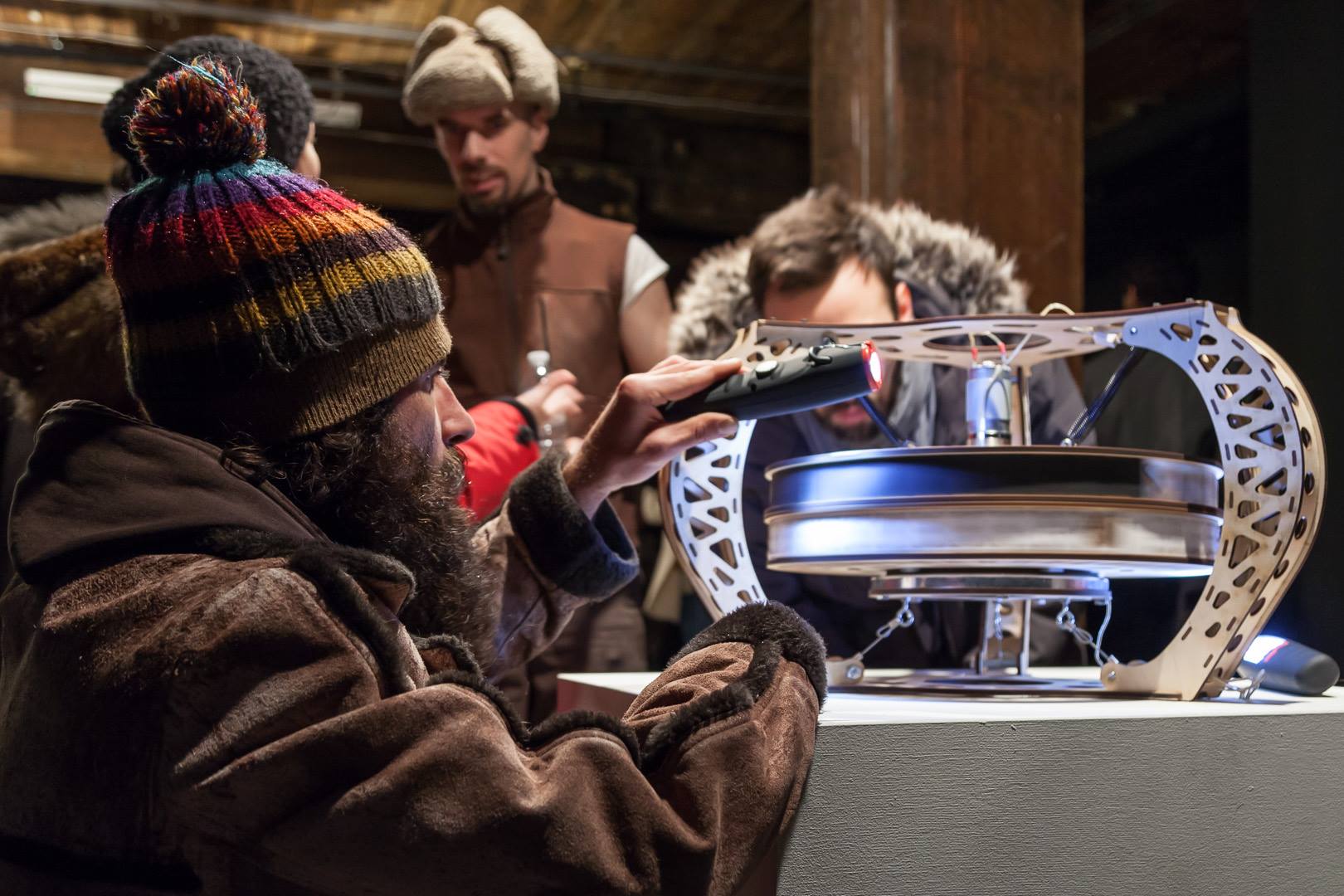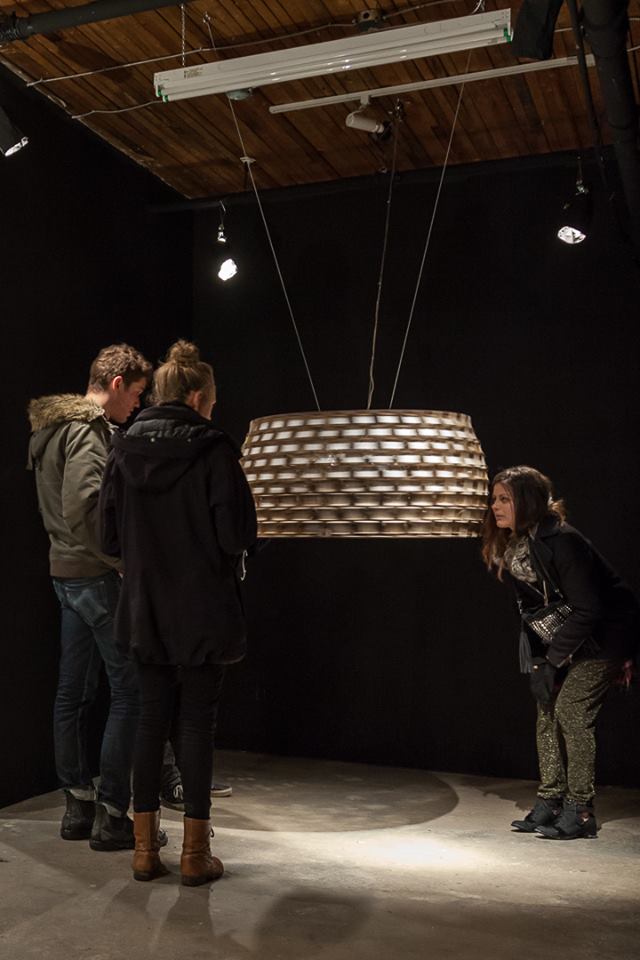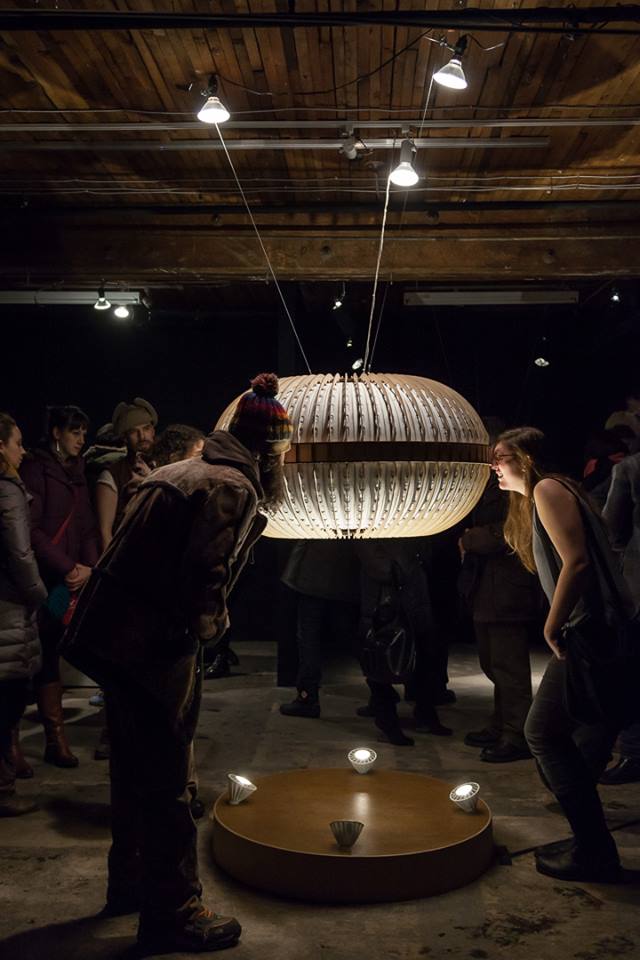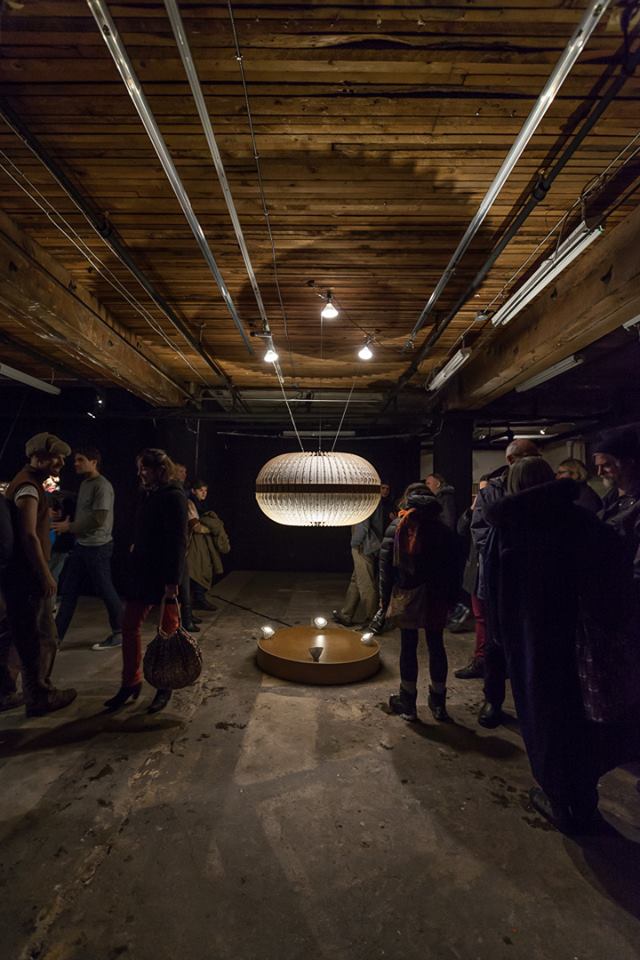Use the scroll buttons at image Top-Right or use keyboard ‘Right’ and ‘Left’ arrow keys to navigate the sideshow.
Images © Jacqueline Young
Text by Tom Kohut
Apparatus – Synopsis
Apparatus is mechanism as ruin. It is a decaying monument that realizes a historical vision of future utopias, dragging them back toward obsolescence, futility and critique.
The apparatus commemorates a future where vision is total and simultaneous; a future where experience, labour and action are absorbed by the apparatus and made assessable as history.
Apparatus – Andrew J. Milne
What is an apparatus? This question, which forms the basis of Giorgio Agamben’s collection of essays of the same name, also resonates throughout descriptions of the contemporary world. We have the disciplinary apparatuses of Foucault, Deleuze and Guattari’s apparatuses of capture, Althusser’s Ideological State Apparatus, Vilém Flusser’s apparatus-operator complex, etc.: in all of these cases, there is an ambiguity as to the agency of these automatic mechanisms. We have designed them to be semi-autonomous, to carry out tasks that are too complex and labour-intensive to be performed manually. (The calculations that would be required to design a website, for example, would be impossible, or at least incredibly difficult and time-consuming, without the availability of the shortcuts and automated algorithms of code). But this relative degree of autonomy is also cause for alarm: what if the apparatuses start doing something that we would prefer them not to? Or perhaps, an even more alarming possibility hinted at by McLuhan’s speculation that human beings have become the servo-mechanisms of our technologies: that the apparatuses we have built do not exist for us, but rather that we exist for them.
At the same time, there has been a growing interest in machine malfunction: the glitched-out cuteness of the New Aesthetic, on the one hand, and the widespread interest in the dilapidation of those more Utopian moments of twentieth century architecture on the other. Regarding the latter, Douglas Murphy, in The Architecture of Failure, focuses on nineteenth century steel and glass buildings – the Hyde Park Crystal Palace (1851), the Crystal Palace at Sydenham (1854-1936) and the “almost completely unremembered Albert Palace (1885-92)” in order to examine a paradox: these buildings were monuments to the engineering, technological, architectural (and colonial) wonders of their age, as well as serving as precursors to twentieth century modernism, and they exist only as archival traces, falling into neglect and ruin with alarming rapidity. Murphy’s thesis is that this paradox is currently enacted in our own present digital stage: “… the hyper-connectivity of the digital world generates similar reactions to those which the iron & glass revolution inspired; it functions both as a symbol of utopia for radicals, democratic, universal, free, but also as a terrifying symbol of control; trails of information, security networks and so on.” The bracketing together of Victorian ferro-vitreous architecture and apparently seamless, unblemished (save during malfunction) surfaces of the digital augmentation of the world contains a premonitory point: that ruination is encoded in the apparatus, that the dematerialization prefigured by the Crystal Palace and actualized in the present digital situation leads inexorably to disappearance.
These are the conceptual problems that inform Andrew Milne’s Apparatus. Milne has constructed three large (26-44 inches by 8-24 inches) machines: a zoetropic apparatus, a praxiniscopic apparatus and a kinesigraphic apparatus. These apparatuses are contemporary adaptations of nineteenth century imaging devices: the zoetrope, mass-produced as a children’s toy in the 1860s, consisted of a cylinder with slits cut vertically in the sides, with a printed band of sequenced pictures set inside. As the cylinder rotated, the images would be viewed through the slits in the cylinder; the rapid succession of these sequential images would, through persistence of images, produce the illusion of motion. The praxinoscope, invented in France in 1877 by Charles-Émile Reynauld, refined the zoetrope by replacing the viewing slits with an inner circle of mirrors, allowing the images to appear more stationary in position as the wheel turned, thereby resulting in a more high-definition moving image. Like the zoetrope, the praxinoscope was popular among children as an early mode of generating and enjoying animated cartoons. The kinesigraph was patented by the English anarchist and chess enthusiast Wordsworth Donisthorpe in 1876; the device was an ur-cinematic camera, allowing the operator to take succession of photographs at equal intervals in time in order to record the movements of the object being photographed. The result was an early form of film reel, the projection of which was accomplished in 1894. Obviously, all of these devices were eclipsed by the Lumière brothers’ innovations to the photographic film projector, but in constructing new versions of these devices, Milne adds a further innovation: holography. In the case of the zoetrope, Milne has added mirrors to the interior raster, enabling the image to be projected through the slits outwards towards the viewer (as opposed to the viewer looking into images moving within the paper band that lies within the cylinder). The effect here is to create the sense of a three-dimensional figure moving horizontally; if one views the images from one side of the circle, one is presented with a single point of view (e.g. the front of the figure), but if one views the image from the 180 degree opposite side of the circle, one is presented the back of the image. Similarly, the reinvented praxinoscope projects movement toward the viewers, but this time along the vertical, rather than horizontal, axis which allows for the illusion of perspective, of viewing a body in perspectival space (albeit perspectival space that is, again, projected towards the viewer). This sense of an image in three dimensions is further developed in the re-imagined kinesigraph. Here, the figure is seen from a single perspective and rotates on a ninety degree pivot: in this case, the truest sense of a hologram as it is generally understood.
It is important to stress that none of this is done through the use of digital computing technology; the images that are projected are composed of many, many different two dimensional images printed on paper, the illusion of motion and three-dimensionality created by the purely mechanical means (motors, metal, wood, paper, light bulbs) of the apparatus, on the one hand, and from the contingent design flaws of the viewers’ optical mechanism (the human retinal persistence of vision) on the other. And yet, the work is nonetheless digital, in the sense of being composed of discrete, discontinuous elements operating at two levels: the serial images of a nude male figure walking that are the hulé (substance) of the illusory three-dimensional, mobile image and the slits and cells through which the viewers observe the image. The three-dimensional eîdos (form) of the images produced by these apparatuses reflects this discontinuity (unlike more technologically advanced holograms whose appearance is smooth, over lit and strangely boring). The question then becomes: why? Undoubtedly, there is considerable mechanical inventiveness and creativity in conceiving and building what are essentially Rube Goldenberg versions of a digital image-producing devices, but what larger purpose is attracting Milne, and the viewers of these beautifully designed machines, to embark on this exercise in retrospective projection?
The answer is connected to the technical limitations of the device. As nineteenth-century ferro-vitreous architecture, in Murphy’s text, reveals certain in-built contradictions in contemporary digital architecture, so Milne’s apparatuses reveal that even the most sophisticated digital image is precisely that: a digital eîdos predicated on discontinuous hulé, an illusory effect of completion that conceals the digital image’s substrate as quanta separated by intervals. However, I want to suggest a further refinement of this picture, which has to do with the status of the interval. In the atomistic picture inherited from Democritus, we have the postulation that, as Mladen Dolar puts it, “at bottom we always have not a unity, but a unity split into something and a void,” or, more precisely, “being is divisible by one, not indivisible as one. … The moment one posits this ‘one’ as the elementary particle of being, one posits, in the very same breath, the void which separates the atom and which enables their movement, even more, which is the very principle of their movement. Thereby one posits the non-being at the core of being.” Milne’s apparatuses, at first glance, appear to be nothing if not atomistic in this sense; particles swerving (clinamen) through a void producing (the illusion of three-dimensional) matter. Indeed, this atomistic picture informs Vilém Flusser’s analysis of technologically produced images; they too are quanta of information with, as he puts it in Into the Universe of Technical Images, “the void of the intervals that hold the elemental points apart.” However, as Aleš Bunta points out, “the atomistic concept of the void is built on a series of paradoxes” that are un-resolvable within the bounds of the atomistic conception. Bunta characterizes these paradoxes thusly: “either, do we consider matter and void as fundamentally different, which will finally result in the thesis that the void – as the exclusive location of matter’s presence in the Universe, which itself exists independently of matter – is the unconditioned condition of matter’s ‘being there.’ Or do we … grasp them in their indifference, which will necessarily result in the thesis that matter qua matter is merely a certain type of presentation of the void. The question seems to be, of course, why it is necessary to exclude the opposite (or third) speculative option, i.e. that the void is merely a certain appearing of matter?” Is it not possible to conclude, then, that the metaphysical point made by Milne’s Apparatus is precisely this last option: that the apparition of the holographic imagery is a mode of signalling the void as appearance of matter, not as privation, but as excess?
Tom Kohut
January 2014
Andrew John Milne – Bio
Andrew John Milne is a self-taught Media, Film and Performance artist living and working in Winnipeg Manitoba. He has a background in mechanical, electrical and computer design, contemporary dance, photography and film. Over the past 5 years Andrew has created a series of Post-Cinematic Mechanisms which interrogate the technologies of seeing. In this work he approaches cutting edge media with obsolesced technologies.
As well as maintaining an active personal practice Andrew is the founder of the Museum of New Ideas, a mobile media art exhibition and studio space, and is a founding member of Bent Light a post-cinema film collective.
In Partnership with Video Pool


